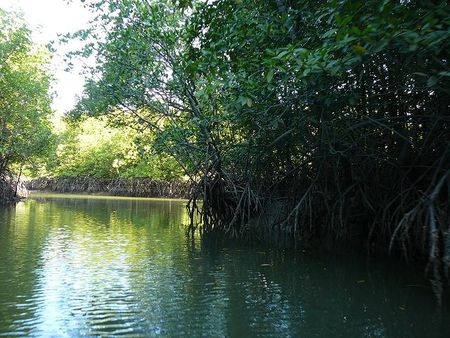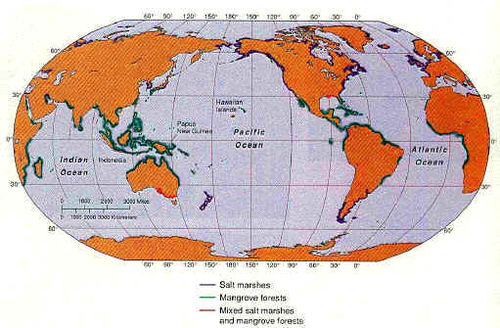Mangroves
This article describes the habitat of the Mangrove forests. It is one of the sub-categories within the section dealing with biodiversity of marine habitats and ecosystems. It gives an overview about the characteristics, distribution, biota, functioning and adaptation to general problems the organisms are facing with. A short discussion about the threats is also present.
Introduction
Mangroves are the only trees that are capable of thriving in salt water. They form unique intertidal forests at the edge of land and sea. They are represented on all continents with tropical and subtropical coasts, i.e. North and South America, Africa and Middle-East, Asia and Oceania (incl. Australia). [1]
Mangrove forests or mangals are a type of intertidal wetland ecosystems. The word mangrove is derived from the Portugese word mangue which means “tree” and the English word grove which is used for trees and shrubs that are found in shallow, sandy or muddy areas. [2] They replace Salt Marshes in tropical and subtropical regions.
They are salt-tolerant forested wetlands at the sea-land interface which forms the link between the terrestrial landscapes and the marine environment. The dominant plants are several species of mangrove (for a species overview, check the Mangrove Species Database [3]).
Mangroves are woody trees and shrubs with a thick, partially exposed network of roots that grow down from the branches into the water and sediment. They occur where there is little wave action and where sediments accumulate. These fine grained (muddy and sandy) sediments lack oxygen. [4]
They are frequently associated with saline lagoons and are regularly found on protected sides of islands, atolls and tropical estuaries. [5]

Distribution
The distribution, density and species composition are determined by the water and air temperatures during the winter, exposure to wave action and tidal currents, the range of the tide, the type of sediment and the chemistry of the seawater. The most highly developed and most species rich mangals are found in Malaysia and Indonesia. Over the world, 54-70 species (for a species overview, check the Mangrove Species Database [7])(and hybrids) in 20-27 genera and 16-19 families are found. [8]
They are almost exclusively tropical, but are also seen in the subtropics. Mangroves are intolerant of frost, but can tolerate air temperatures as low as 5°C. They are most closely correlated with the seawater temperature. The 20°C isotherm in the winter is a good indicator for the limit of distribution. The number of species tends to decrease with the distance from the equator. In the southern hemisphere, ranges extend further south on the eastern margins of land masses than on the western. This is because of the pattern of warm and cold ocean currents. But local anomalies of current and temperature or the local evolution can create local changes. [9] [10]

References
- ↑ http://www.vliz.be/vmdcdata/mangroves
- ↑ Karleskint G. 1998. Introduction to marine biology. Harcourt Brace College Publishers. p.378
- ↑ http://www.vliz.be/vmdcdata/mangroves
- ↑ Hogarth P.J. 1999. The biology of mangroves. Oxford University Press. p.228
- ↑ Karleskint G. 1998. Introduction to marine biology. Harcourt Brace College Publishers. p.378
- ↑ http://teqje.web-log.nl
- ↑ http://www.vliz.be/vmdcdata/mangroves
- ↑ Bertness M.D. Gaines S.D. Hay M.E. 2001. Marine Community Ecology. Sinauer Associates, Inc. p. 550
- ↑ Pinet P.R. 1998.Invitation to Oceanography. Jones and Barlett Publishers. p. 508
- ↑ Hogarth P.J. 1999. The biology of mangroves. Oxford University Press. p.228
- ↑ Richard Parker
Please note that others may also have edited the contents of this article.
|